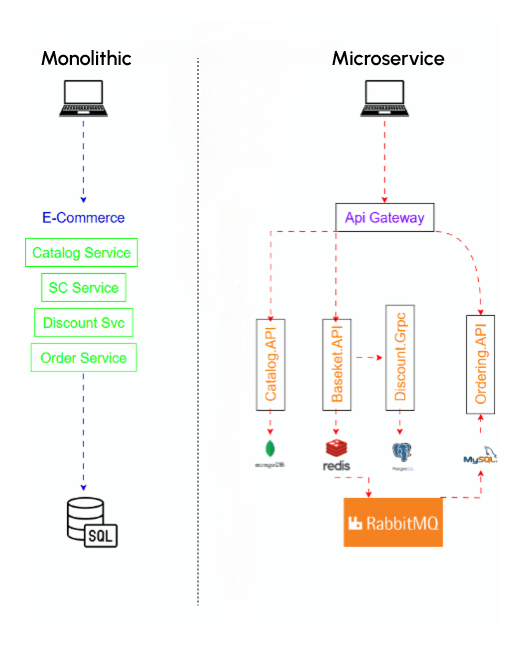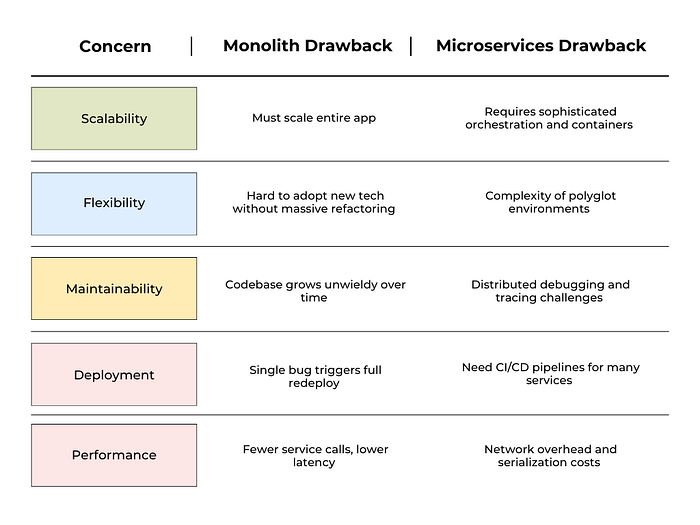Monolithic vs Microservice
 Bluell AB
Bluell AB
I once inherited a massive monolithic codebase that felt like a tangled ball of yarn, deploying a tiny change meant shipping the entire app and praying nothing broke.
After migrating to microservices, I watched as each service could be scaled, tested, and deployed on its own , no more all‑or‑nothing releases.

Monolithic vs Microservice
In this article, you’ll learn when a single‑unit monolith keeps things simple and when splitting into microservices supercharges your team’s agility and app reliability.
Ready to see which path saves you headaches and speeds up delivery?
Let’s start.
Monolithic Architecture
In a monolithic setup, your entire application, UI, business logic, and data access live in one codebase and run as a single service.
This simplicity makes it fast to develop and test early on.
Microservices Architecture
A microservices approach breaks your app into many small, independent services, each responsible for a specific function.
They communicate over networks (often via HTTP/REST or messaging) and can be built, deployed, and scaled independently.
Why Start with a Monolith?
Simplicity & Speed
One codebase: no complex orchestration.
Faster initial development and testing cycles.
Better Performance
- Fewer network hops, internal calls stay in-process.
Reduced Overhead
No need for service discovery or distributed tracing.
Easier deployment: deploy one artifact.
When to Choose: Small to medium apps, startups racing to market, or teams new to distributed systems.
When to Go Microservices
Independent Scalability
- Scale only hot services (e.g., billing) without scaling the whole app.
Technology Flexibility
- Mix languages and frameworks per service (e.g., Node.js for API, Python for ML).
Resilience
- One service failure doesn’t crash the entire system.
Smaller Codebases
- Easier to understand and maintain each service's scope.
When to Choose: Large, complex applications, enterprises with multiple teams, or systems requiring high availability and frequent independent releases.
Trade-offs: What You Give Up

Choosing the Right Path
Assess Your Team
Small team? Lean monolith.
Multiple specialized teams? Microservices scale with team autonomy.
Define Your Domain
Well-bounded, independent domains reward microservices.
Highly coupled features suit a monolith initially.
Plan Your Growth
Start monolithic: get to market fast, then refactor into microservices when needed.
If you expect rapid scaling from day one, invest in microservices upfront.
Invest in Automation
Microservices demand automation: containers (Docker), orchestration (Kubernetes), and monitoring (Prometheus).
Monoliths still benefit from CI/CD and automated testing to maintain quality.
Wrapping Up
There’s no one-size-fits-all answer…
Monolithic architectures shine for speed, simplicity, and performance at a small scale.
Microservices offer unmatched flexibility, resilience, and scalability for complex, distributed systems.
Evaluate your team size, application complexity, and growth plans to choose wisely.
Many successful companies start monolithic, then evolve into microservices when the time and resources are right.
Did this guide help you decide your architecture?

Hit that clap button, share with fellow devs, and let’s keep building better software together!
Subscribe to my newsletter
Read articles from Bluell AB directly inside your inbox. Subscribe to the newsletter, and don't miss out.
Written by
